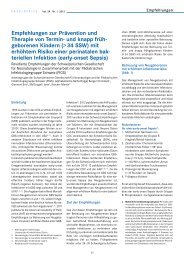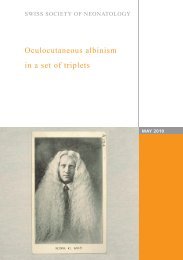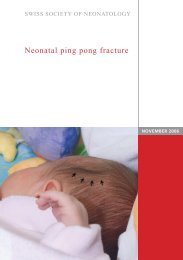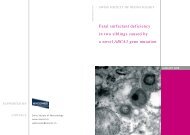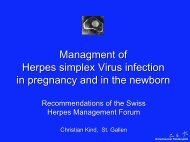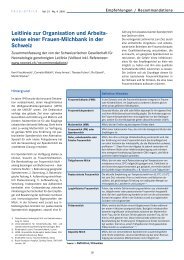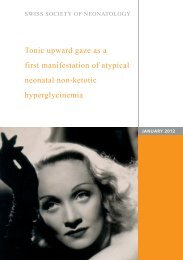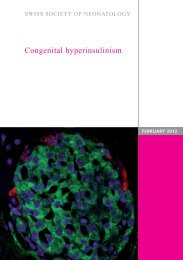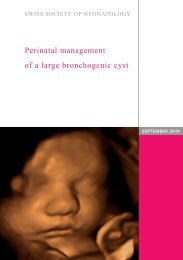Ankyloblepharon filiforme adnatum - Swiss Society of Neonatology
Ankyloblepharon filiforme adnatum - Swiss Society of Neonatology
Ankyloblepharon filiforme adnatum - Swiss Society of Neonatology
Create successful ePaper yourself
Turn your PDF publications into a flip-book with our unique Google optimized e-Paper software.
7<br />
AFA is defined by partial or complete eyelid adhesion<br />
with a single or multiple bands <strong>of</strong> fibrous tissue verti-<br />
cally attached to upper and lower eyelids. The develo-<br />
ping eyelid margins remain fused until the fifth month<br />
<strong>of</strong> gestation but may not be completely separated<br />
until the seventh month (1). The etiology <strong>of</strong> AFA is<br />
unknown, but failure <strong>of</strong> apoptosis at a critical stage in<br />
eyelid development has been suggested (2).<br />
Usually, AFA constitutes a solitary malformation, as in<br />
our case, with sporadic occurrence and an incidence<br />
<strong>of</strong> 4.4 per 100.000 births (3, 4). However, it can be<br />
associated with several disorders such as trisomy 18<br />
(Edward’s syndrome) (5), Hay-Wells syndrome (a va-<br />
riant <strong>of</strong> the ectodactyly-ectodermal dysplasia-cleft lip<br />
palate syndrome) (6), popliteal pterygium syndrome<br />
(characterised by intercrural webbing <strong>of</strong> the lower<br />
limbs) (7), CHANDS (curly hair-ankyloblepharon-nail<br />
dysplasia) (8) and cleft lip and palate (9). Other associ-<br />
ations may include hydrocephalus, meningomyelo-<br />
coele, imperforate anus (10), bilateral syndactyly (7),<br />
infantile glaucoma (11), and cardiac problems such as<br />
patent ductus arteriosus and ventricular septal defects<br />
(7).<br />
AFA is diagnosed clinically and the treatment consists<br />
<strong>of</strong> simple surgical resection <strong>of</strong> the fibrous bands. Ozy-<br />
azgan et al. (12) have described treating AFA under<br />
intravenous sedation, and Ioannides et al. (13) with<br />
the aid <strong>of</strong> topical anesthesia. In our patient, no seda-<br />
DISCUSSION



